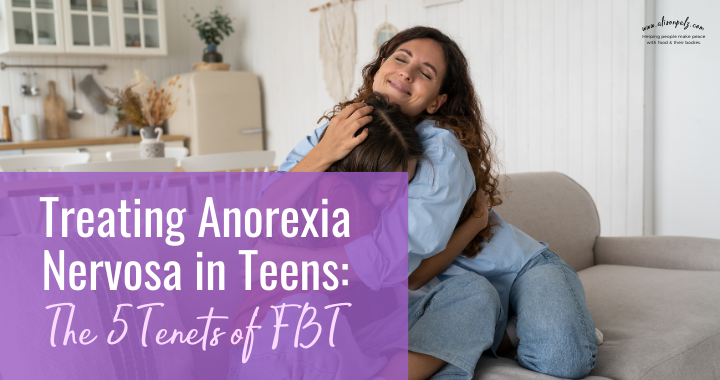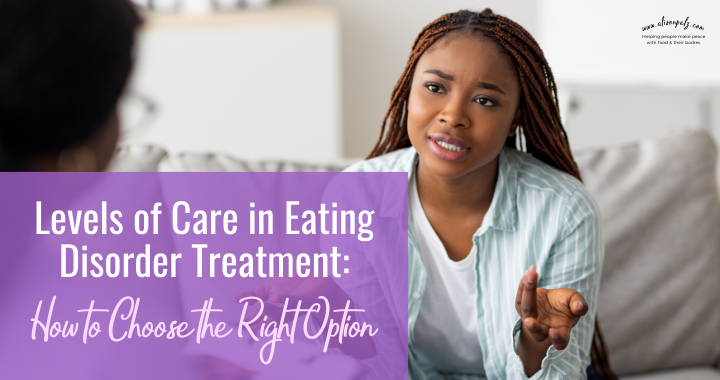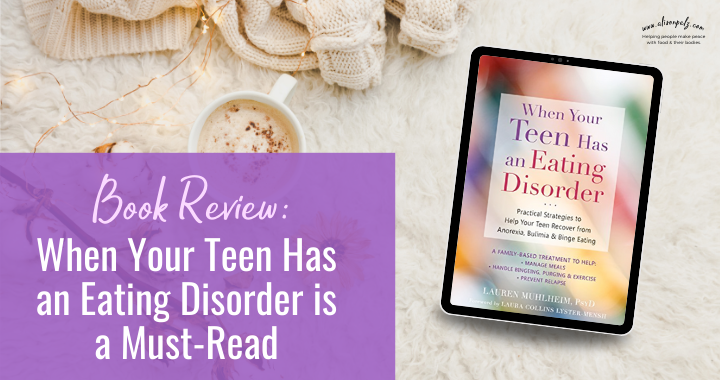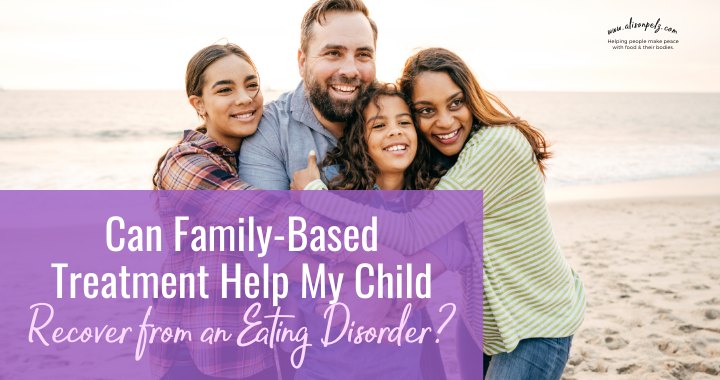You may feel confused, scared, frustrated, and maybe even hopeless if your teen has an eating disorder like anorexia nervosa. You have seen your fun-loving and bright teen change drastically, becoming a shell of their usual self.
There are many types of treatments for eating disorders that work for teens and their families. Cognitive behavior therapy (CBT), dialectical behavioral therapy (DBT), Family-Based Treatment (FBT), and Acceptance and Commitment Therapy (ACT) are a few of the common treatment modalities that are used in eating disorder recovery. Additionally, there are different levels of care available for those with eating disorders, such as hospitalization, residential, partial hospitalization, or outpatient treatment.
Looking at all of the treatment options for anorexia nervosa in teens may feel daunting.
In this article, the focus is on family-based treatment (FBT), one type of treatment for eating disorders that is used for treating anorexia nervosa in teens. In particular, this article discusses the nuances of family-based treatment, which are referred to as the “Tenets of FBT”.
The focus of FBT is to empower you, the parent, to provide nutrition rehabilitation and restore your child back to health with the guidance of a treatment team. FBT is an outpatient treatment that can be used in place of residential treatment or partial hospitalization if your teen is medically stable. That means your teen can stay at home during treatment.
The tenets of Family-Based Therapy guide me as a clinician, and you as a parent, during eating disorder treatment and recovery. When working with families and teens throughout treatment I refer to these guiding principles frequently.
5 Tenets of Family-Based Treatment for Anorexia Nervosa in teens
Agnostic view of the eating disorder
In FBT, the focus shifts from why your teen developed the eating disorder to treating the eating disorder.
Eating disorders are complex disorders and can develop for a myriad of psychological, biological, social, and medical reasons, and beyond. The parents and the teen are not to blame for the eating disorder. I know it may feel like your teen is choosing their eating disorder because they are restricting food or purging, but they are not.
Additionally, parents don’t cause eating disorders-so let yourself off the hook.
How this is helpful:
It reduces blame, guilt, and shame for the teen, as well as their parents. It focuses on stopping the eating disorder in its tracks, restoring your teen’s health, shortening the length of illness, and preventing the eating disorder from becoming chronic.
This is similar to if you found out you had cancer. You or your doctor initially wouldn’t spend a lot of time figuring out why you have cancer but rather focus on how to treat the cancer. Treatment for an eating disorder is similar, including for anorexia nervosa in teens.
Externalization of the illness
Externalization of the illness is a tool to understand that the eating disorder is separate from your teen. Although it may appear on the surface that your teen is refusing food, it is the anorexia that causes the food refusal.
Externalization is commonly utilized in the treatment of OCD, schizophrenia, and other mental health conditions.
How this is helpful:
This helps families understand how to separate their loved one from their eating disorder which can reduce blame and shame. The spirit of treatment feels more like us (family and teen) vs. the eating disorder, in contrast to parents vs. the teen. FBT helps you call on your years of parental experience and wisdom to help heal your child. This can often increase parental empowerment leading to more successful nutrition rehabilitation.
An increase in connection between parents and teen is what I have observed when working with families during eating disorder treatment. Increased connection can contribute to improved physical and mental health for the whole family.
The therapist takes a non-authoritarian stance
In traditional adolescent-focused therapy, the therapist works predominantly with the teen, and the therapist is leading the treatment. In contrast, in FBT, the therapist acts more like a coach.
“The therapists are experts on eating disorders and parents are experts on their family and teen,” is something I learned during my training in FBT. This lends itself to high amounts of collaboration between the therapist and family. Additionally, FBT utilizes the strengths of the teen to help aid in the healing process.
How this helps:
FBT is “not a one size fits all approach” to treating anorexia nervosa in teens. In Family-Based Treatment, the therapist activates the problem-solving skills of the family.
In other words, the therapist is there to help guide you and your child through recovery – but you know your child best and what has helped them with other struggles in the past. This knowledge is essential as you work together toward recovery.
Additionally, FBT appreciates the uniqueness of each family and their teen including culture, gender, abilities, exceptionalities, neurodiversity, religion, and family values to name a few.
Parental empowerment
Simply put, parental empowerment means that parents feel confident about taking care of their children. Some parents have some experience with feeling empowered with things like setting a curfew, boundaries around school work, and expectations around chores, while others might second-guess their parenting choices. FBT is an opportunity for growth in this area.
One of the tasks of the FBT therapist is to help you harness the skills and confidence that you already have as a parent, and apply them to renourishing your teen.
How this helps:
Empowered parents can be more effective at renourishing their teen. Since you, as the parent, are in charge of feeding your teen, it reduces distress and second-guessing about what and how much to feed your teen.
Furthermore, empowered parents provide structure, consistency and boundaries that help children and teens thrive.
Pragmatic approach
The initial focus of FBT is symptom reduction rather than focusing on why the eating disorder developed. In the case of anorexia nervosa in teens, parents are tasked with the nutrition rehabilitation of their child, similar to the staff at a residential treatment center. This allows the family to stay together during treatment.
How this is helpful:
This approach stops the eating disorder from getting worse, which can lead to medical complications or potentially death. Stopping the eating disorder behaviors will help keep them from becoming habitual for your teen.
One hypothesis for why eating disorders develop is that eating disorders have a function. That is, they are helpful in some way, despite causing physical harm. For example, if someone smokes a cigarette, although the cigarette is physically harmful, it reduces stress for the smoker in the short term. Eating disorders are thought to function in the same way.
In my work, I have witnessed families rally around their teens, and through connection and compassion help their teen develop new skills to manage life stressors so the eating disorder is no longer needed.





